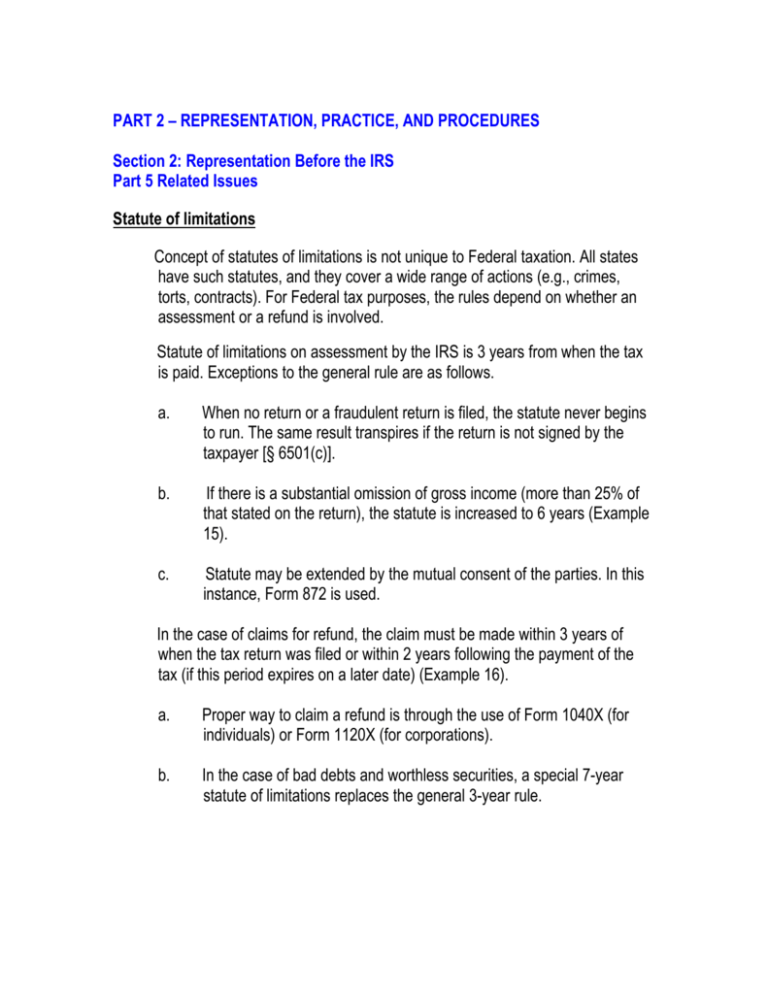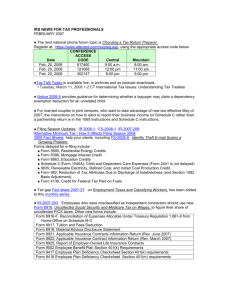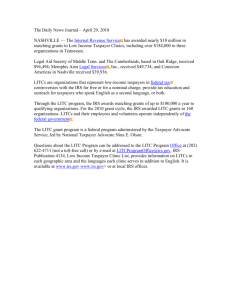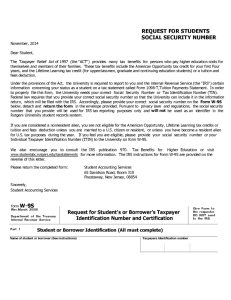Part 6 Related Issues Lecture
advertisement

PART 2 – REPRESENTATION, PRACTICE, AND PROCEDURES Section 2: Representation Before the IRS Part 5 Related Issues Statute of limitations Concept of statutes of limitations is not unique to Federal taxation. All states have such statutes, and they cover a wide range of actions (e.g., crimes, torts, contracts). For Federal tax purposes, the rules depend on whether an assessment or a refund is involved. Statute of limitations on assessment by the IRS is 3 years from when the tax is paid. Exceptions to the general rule are as follows. a. When no return or a fraudulent return is filed, the statute never begins to run. The same result transpires if the return is not signed by the taxpayer [§ 6501(c)]. b. If there is a substantial omission of gross income (more than 25% of that stated on the return), the statute is increased to 6 years (Example 15). c. Statute may be extended by the mutual consent of the parties. In this instance, Form 872 is used. In the case of claims for refund, the claim must be made within 3 years of when the tax return was filed or within 2 years following the payment of the tax (if this period expires on a later date) (Example 16). a. Proper way to claim a refund is through the use of Form 1040X (for individuals) or Form 1120X (for corporations). b. In the case of bad debts and worthless securities, a special 7-year statute of limitations replaces the general 3-year rule. Post-filing correspondence (e.g., math error notices, under reporting notices) Every year the Internal Revenue Service sends millions of letters and notices to taxpayers, but that doesn’t mean taxpayers need to worry. Here are eight things every taxpayer should know about IRS notices. 1. Don’t panic. Many of these letters can be dealt with simply and painlessly. 2. There are number of reasons the IRS sends notices to taxpayers. The notice may request payment of taxes, notify you of a change to your account or request additional information. The notice you receive normally covers a very specific issue about your account or tax return. 3. Each letter and notice offers specific instructions on what you need to do to satisfy the inquiry. 4. If you receive a correction notice, you should review the correspondence and compare it with the information on your return. 5. If you agree with the correction to your account, usually no reply is necessary unless a payment is due. 6. If you do not agree with the correction the IRS made, it is important that you respond as requested. Write to explain why you disagree. Include any documents and information you wish the IRS to consider, along with the bottom tear-off portion of the notice. Mail the information to the IRS address shown in the lower left part of the notice. Allow at least 30 days for a response. 7. Most correspondence can be handled without calling or visiting an IRS office. However, if you have questions, call the telephone number in the upper right corner of the notice. Have a copy of your tax return and the correspondence available when you call. 8. It’s important that you keep copies of any correspondence with your records. Deadlines and timeliness requirements There are possible exceptions to the general deadlines for filing a return and paying tax. One possible exception is if a taxpayer is a member of the armed forces and serving in a combat zone. Refer to Publication 3, Armed Forces' Tax Guide, for additional information and qualifications. The second is if a taxpayer is a citizen or resident alien working abroad. Refer to Publication 54, Tax Guide for U. S. Citizens and Resident Aliens Abroad, for information. Third-party correspondence (e.g., witness communications, employment records) If taxpayers believe there is an error on their notice or bill, they should write to the IRS office that sent the notice, within the time frame given. Provide photocopies of any records that may help correct the error. Also, call the number listed on the notice or bill for assistance. If the information provided is correct, the IRS will make the necessary adjustment to the account and send a corrected notice. Freedom of Information Act requests Enacted in 1966, the Freedom of Information Act, or FOIA, gives any person the • right to access federal agency records or information. The FOIA is based on the presumption that the government and its information belong to the people. A 1996 amendment to the FOIA, required federal agencies to make many types of • records available online. New law, like the OPEN Government Act, as well as new policies, such as those • issued by the President and the Attorney General, promote the spirit of transparency envisioned by our founding fathers. • Some records are only available by written request. If you plan to make a FOIA request to obtain the records you seek, you may refer to the IRS FOIA Guide. IRS may withhold records protected from disclosure by one of the law’s nine exemptions and it must withhold when disclosure of the records is prohibited by law. • As an alternative to filing formal FOIA requests, the IRS offers access to other records through procedures designed to make access quick and easy. To assist FOIA requesters each IRS Disclosure Office serves as a FOIA Service Center and each Disclosure Manager is a FOIA Public Liaison. These liaisons are advocates for FOIA requesters to help resolve problems encountered in the process. Tax avoidance vs. tax evasion Taxpayer’s will be subjected to criminal prosecution for actions such as: • • • • • Tax Evasion Willful failure to file a return, supply information, or pay any tax due Fraud or false statements Preparing and filing a fraudulent return Identity theft Taxpayer Advocate Service (e.g., criteria for requisition assistance) The Taxpayer Advocate Service (TAS) is Your Voice at the IRS. The mission is to ensure that every taxpayer is treated fairly, and that taxpayers know and understand their rights. TAS offers free help to guide through the often-confusing process of resolving tax problems that haven’t been solved. As an independent organization within the IRS, TAS helps taxpayers resolve problems with the IRS and recommends changes that will prevent the problems. TAS can help resolve problems with the IRS if: • The problem is causing financial difficulties for the taxpayer, the taxpayer’s family, or the taxpayer’s business. • The taxpayer or the taxpayer’s business is facing an immediate threat of adverse action. • The taxpayer has tried repeatedly to contact the IRS but no one has responded, or the IRS has not responded by the date promised. Qualifying taxpayers will receive personalized service from a knowledgeable taxpayer advocate who will: • Listen to their problems, • Help them understand what needs to be done to resolve the problems, and • Stay with them every step of the way until the problems are resolved. Fast Facts • TAS received nearly 220,000 new cases in fiscal year 2012 (10/1/11 – 9/30/12), and provided full or partial relief to the taxpayers in nearly 77 percent of the cases it closed. • More than half of the new cases involve taxpayers who are experiencing financial problems because of their tax issues. • Identity theft was the most common issue in TAS casework and rose 61 percent over the last fiscal year. • Congress has enacted numerous legislative recommendations from the National Taxpayer Advocate's Annual Reports to Congress. Identity Theft The IRS is committed to working with taxpayers who are the victims of identity theft The IRS has taken numerous steps to combat identity theft and protect taxpayers. The IRS is continually looking at ways to increase data security and protect taxpayers' identities with assistance from our Identity Protection Specialized Unit. Identity theft cases are among the most complex ones we handle. Identity theft is a frustrating process for victims. This issue is very serious and continues to expand a robust screening process in order to stop fraudulent returns and protect innocent taxpayers. Depending upon the personal circumstances, the information found here will cover a variety of scenarios involving identity theft, ranging from a case of identity theft to providing tips to help keep your records safe: Victim of identity theft? Lost or stolen wallet? Protect yourself IRS action on identity theft Additional helpful resources Taxpayer Guide to Identity Theft Special Identity Theft Enforcement Efforts Law Enforcement Assistance Pilot Program Higher levels of representation beyond the scope of EA representation (e.g., tax court, Trial Courts. Courts in which a taxpayer may pursue a tax conflict are as follows. a. Single U.S. Court of Federal Claims hears tax and other Federal government cases. Has 16 judges. b. Single U.S. Tax Court hears only tax cases. Has 19 judges. c. Small Cases Division of U.S. Tax Court. The broken line between the U.S. Tax Court and the Small Cases Division in text Figure 1.1 indicates that there is no appeal from the Small Cases Division. This court involves informal cases of $50,000 or less. d. There are numerous U.S. District Courts based on geographical locations. Each court has 1 judge and taxpayers can have a jury trial. e. Concept Summary 1.1 in the text provides a summary of the organization of the tax trial courts. It is the policy of the Internal Revenue Service to announce at an early date whether it will follow the holdings in certain cases. An Action on Decision is the document making such an announcement. An Action on Decision will be issued at the discretion of the Service only on unappealed issues decided adverse to the government. Generally, an Action on Decision is issued where its guidance would be helpful to Service personnel working with the same or similar issues. Unlike a Treasury Regulation or a Revenue Ruling, an Action on Decision is not an affirmative statement of Service position. It is not intended to serve as public guidance and may not be cited as precedent. Actions on Decisions shall be relied upon within the Service only as conclusions applying the law to the facts in the particular case at the time the Action on Decision was issued. Caution should be exercised in extending the recommendation of the Action on Decision to similar cases where the facts are different. Moreover, the recommendation in the Action on Decision may be superseded by new legislation, regulations, rulings, cases, or Actions on Decisions. Prior to 1991, the Service published acquiescence or nonacquiescence only in certain regular Tax Court opinions. The Service has expanded its acquiescence program to include other civil tax cases where guidance is determined to be helpful. Accordingly, the Service now may acquiesce or nonacquiesce in the holdings of memorandum Tax Court opinions, as well as those of the United States District Courts, Claims Court, and Circuit Courts of Appeal. Regardless of the court deciding the case, the recommendation of any Action on Decision will be published in the Internal Revenue Bulletin. The recommendation in every Action on Decision will be summarized as acquiescence, acquiescence in result only, or nonacquiescence. Both “acquiescence” and “acquiescence in result only” mean that the Service accepts the holding of the court in a case and that the Service will follow it in disposing of cases with the same controlling facts. However, “acquiescence” indicates neither approval nor disapproval of the reasons assigned by the court for its conclusions; whereas, “acquiescence in result only” indicates disagreement or concern with some or all of those reasons. “Nonacquiescence” signifies that, although no further review was sought, the Service does not agree with the holding of the court and, generally, will not follow the decision in disposing of cases involving other taxpayers. In reference to an opinion of a circuit court of appeals, a “nonacquiescence” indicates that the Service will not follow the holding on a nationwide basis. However, the Service will recognize the precedential impact of the opinion on cases arising within the venue of the deciding circuit. The Actions on Decisions published in the weekly Internal Revenue Bulletin are consolidated semiannually and appear in the first Bulletin for July and the Cumulative Bulletin for the first half of the year. A semiannual consolidation also appears in the first Bulletin for the following January and in the Cumulative Bulletin for the last half of the year. U.S. District Courts and U.S. Claims Court, U.S. Courts of Appeals and U.S. Supreme Court Judicial Process in General. a. b. After a taxpayer has exhausted remedies available within the IRS the dispute can be taken to the Federal courts. (1) First considered by a court of original jurisdiction (trial court). (2) Appeals taken to the appropriate appellate court. (3) 1.1. Federal trial and appellate court system is found in text Figure Precedential Value. American law, following English common law, is frequently “made” by judicial decisions. Under the doctrine of stare decisis, each decision has precedential value for future decisions with the same controlling set of facts. Appellate Courts. Appeal from trial courts are to the U.S. Court of Appeals for the appropriate jurisdiction. a. Generally, a three-judge panel hears a case, but occasionally the full court will decide more controversial conflicts. b. If the IRS or taxpayer loses in a trial court level either or both may appeal. When it loses, the IRS may choose not to appeal for a number of reasons. c. Precedential Value of U.S. Court of Appeals decisions. (1) Trial courts must follow precedents set by the Court of Appeals within their jurisdiction. Tax Court follows the Golsen rule. (2) Court of Appeals need not follow decisions of another Court of Appeals because they are geographical court at the same level. (3) All Courts of Appeals must follow decisions of the U.S. Supreme Court. Supreme Court. a. Appeal to the U.S. Supreme Court requires a Writ of Certiorari. b. If the Court agrees to hear the case, it grants the Writ but most often, it will deny. c. Court grants certiorari to resolve a conflict among the Courts or when the tax issue is extremely important. d. All individuals and the IRS must follow the decisions of the U.S. Supreme Court.




